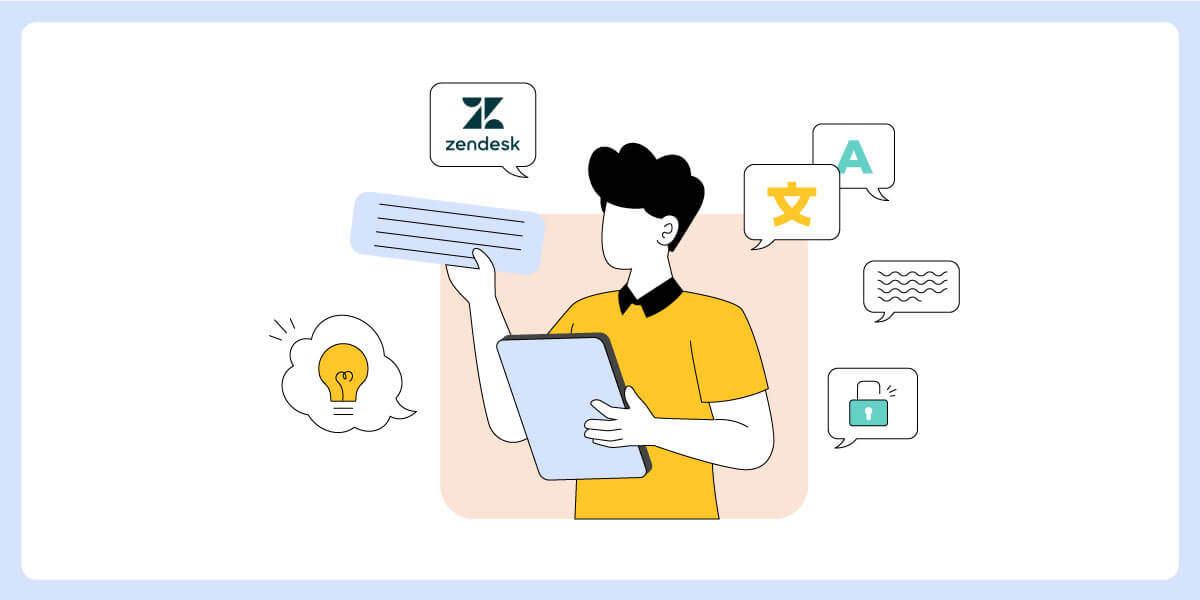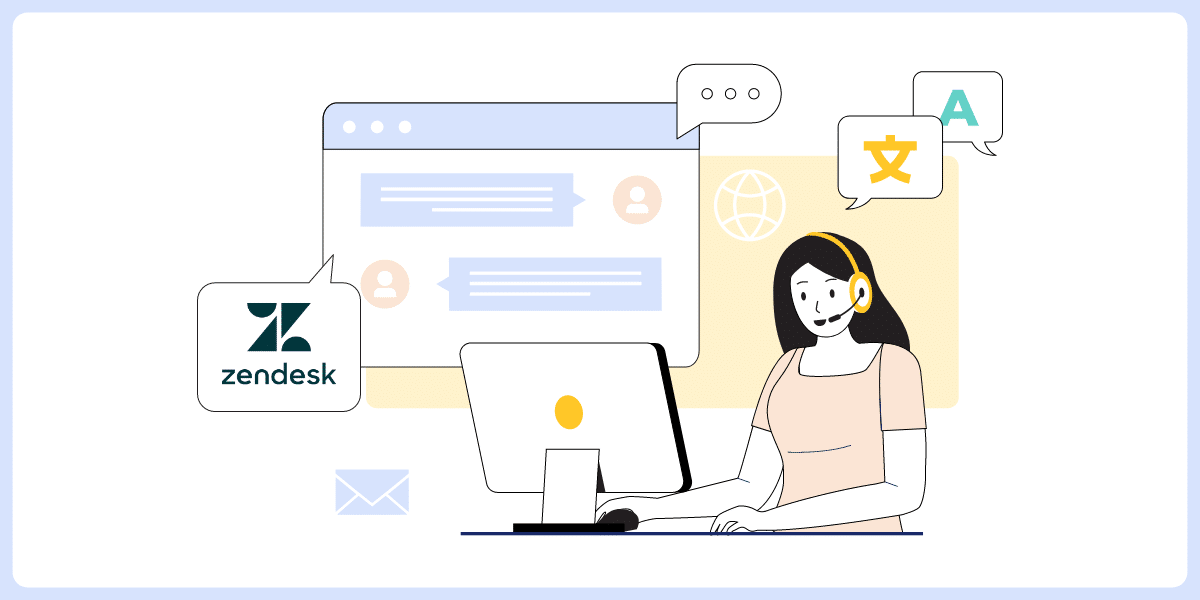Home » E-commerce Localization » 5 Easy Zendesk Translation Hacks for eCommerce Customer Success
5 Easy Zendesk Translation Hacks for eCommerce Customer Success
- | Vijay Khatri

Table of Contents
In today’s time, offering customer support in your customer’s language is no longer an option – it’s a necessity. A survey report published by CSA Research found that 76% of users prefer information in their own language. Another report on Business Wire found that 68% of consumers would switch a brand that offers native language support.
Most e-commerce companies today use a customer service platform for providing the best possible customer service. One of the most popular platform today is Zendesk. Zendesk allows eCommerce support teams to streamline their support workflows and enhance customer experience. It even enable you to offer multilingual customer support to your global customers.
To help you offer effective multilingual support, we’ve come up with some easy to implement Zendesk translation hacks and achieve eCommerce customer success. But first, let’s understand why you need them in the first place:
Why You Need Zendesk Translation Tools for eCommerce
Here are a few reasons why you need an eCommerce support translation tool for your Zendesk customer service platform:
1. Connect with Customers in Their Native Language
Translating your website content is crucial, yet it’s not sufficient when shoppers expect support in their native language. The Business Wire report also mentions that 57% of consumers consider it a bias when brands don’t offer native language support.
But with the ability to communicate in native language at every stage of the buying journey, you can connect with your customers effectively. For instance, providing communication in users’ native language at an early stage can significantly influence their purchasing decisions.
Additionally, native language support during the purchase and fulfillment can streamline the process for your shoppers. Moreover, providing post-sales assistance in the native language can help build a customer base and inspire customers to stay loyal to your brand.
2. Foster Long-term Relations with Your Shoppers
Providing your shoppers with native language support can make them feel you care about them and are ready to do anything to help resolve their issues. A report by ICMI found that 79% of contact centers get customers who speak only their native language and 60% of those expect support in their native language.
With your Zendesk customer service platform, you can provide customers with native language support to make them feel valued and understood. This empathetic approach helps foster a profound connection and build long-term relationships with customers.
3. Maximize Your Customer Support Quality Scores
Your customer support quality scores, such as customer satisfaction (CSAT), increase when you address and provide satisfactory resolution in users’ native language. An article published on Forbes says that 66% of customers will stay loyal to a company that offers positive customer service.
Imagine being in your customers’ shoes who can’t communicate in English. In this case, you’ll want to have a positive experience and probably get support in your native language. But suppose the brand fails to deliver on your expectations; how would you rate the support quality?
Simply put, addressing customers’ needs, such as native language support, will consequently make them feel satisfied with you. But if there’s a language barrier between them and your support team, your shoppers will be stranded with a below-par experience.
4. Personalize Your Customer Service Experience
A report found that offering personalized customer experiences can roughly improve the eCommerce conversion rate by 8%. Multilingual customer support through Zendesk translation tools helps you tailor the service experience shoppers receive.
It gives you a competitive edge over others and makes you stand out from the crowd. And since your eCommerce brand is committed to delivering a friendly, personalized experience, your audience will remember and respect the same.
5 Easy Zendesk Translation Hacks for eCommerce Customer Success
If you use Zendesk for your customer service workflows, here are 5 Zendesk translation hacks or best practices for effective multilingual eCommerce service:
1. Integrate Automated Translation Tool
The Zendesk marketplace allows you to install various translation tools like Lingpad, that help enhance the functionality of your platform. Installing an automated translation tool will enable you to localize customer inquiries and send translated responses.
Look for tools or apps which include features such as AI-powered translation, auto-language detection, contextual translation, and others. They help you automate and streamline your multilingual support conversations with customers.
For instance, if a customer from France sends a query in French, your support agent can localize it to understand the query and provide a resolution in French, ensuring a smooth communication process.
2. Train Your Support Staff
While using these apps in Zendesk is straightforward, there may be some initial challenges in getting your support team accustomed to them. With proper training, your team can quickly adapt to the new tool and use it effectively for two-way support translation within Zendesk.
Your role is to familiarize them with the translation process and quick tours, as they’ll be the ones handling it to offer multilingual customer service. Also, provide them with the necessary materials and guidance on how to use the translation tool to resolve multilingual tickets.
3. Contextualize, Not Just Translate
Translation refers to word-to-word translation of the source content, while localization considers the cultural nuances and context of the language and your brand. In most cases, the same content may have a different meaning in different cultures and languages.
Thus, you need to opt for a support messaging localization tool that offers contextual translation. These tools allow you to respect the cultures of the target language’s region along with your brand context.
This ensures your translation reflects the cultural nuances and your brand’s voice. This consistency in tone across languages builds trust and a stronger brand identity.
4. Use Glossary and Translation Memory
Adding and utilizing the Glossary and Translation Memory (TM) helps you enhance your native language support through Zendesk. A glossary contains terms or phrases specific to your eCommerce brand and uses their approved translations in the target language.
TM, on the other hand, is a database of previously approved translations that you can reuse for future support conversation localization. This helps you save time, translation cost, and effort while increasing your agenst’ productivity.
5. Localize Your Zendesk Guide Articles
Zendesk support translation goes beyond localizing multilingual support tickets translation and supports translation of Zendesk Guide articles. Often, your eCommerce shoppers look for information such as return policy, order tracking guide, etc., in their native language.
The translation tool of your choice should also help you translate your entire help center content to assist customers in their native language. By offering regionalized content that respects customers’ cultural nuances, you can enhance the relevance of your support materials.
Over to You
Embracing multilingual customer support is crucial for eCommerce brands to establish their presence in global markets. Using the 5 easy Zendesk translation hacks described in this article, you’ll be well on your way to achieving eCommerce customer success.
Lingpad is one of the best Zendesk translation tools with a 5-star rating from users. It offers all the features to automate your support conversation and article translation needs. Also, it’s the only tool that can contextualize your translation for relevant and context-aware content.
Book your free demo or start free with us today and pave the way for sustained growth of your eCommerce business across global regions.

Amit Shivani
Amit Shivani is the Director of Sales at Lingpad. His superpower is bridging the gap between client needs and wants along with the sheer determination to redefine sales. Working with various brands to tackle their localization demands brings out his out-of-box, innovative persona. When he is not helping clients achieve expertise-status in their localization journey, he explores cities and street food and works towards gaining expertise-status for himself in photography.
Share this blog:

